Page 180 of 251

Tires
To safely operate your vehicle, your tires must be the proper type andsize, in good condition with adequate
tread, and correctly inflated. The
following pages give more detailed information on how and when to
check air pressure, how to inspect
your tires for damage and wear, and what to do when your tires need to
be replaced.
Inflation
Keeping the tires properly inflated
provides the best combination of
handling, tread life and riding comfort. Underinflated tires wear
unevenly, adversely affect handling and fuel economy, and are more
likely to fail from being overheated. Overinflated tires can make your
vehicle ride more harshly, are more prone to damage from road hazards,and wear unevenly.
We recommend that you visually check your tires every day. If you
think a tire might be low, check it
immediately with a tire gauge. Use a gauge to measure the air
pressure at least once a month. Even
tires that are in good condition may
lose one to two psi (10 to 20 kPa, 0.1 to 0.2 kgf/cm2) per month.Remember to check the spare tire at
the same time you check all the other tires.
Check the pressure in the tires when
they are cold. This means the vehicle
has been parked for at least three
hours. If you have to drive the
vehicle before checking the tire pressure, the tires can still be
considered "cold" if you drive less
than 1 mile (1.6 km).
CONTINUED
Maintenance
Using tires that are excessively
worn or improperly inflated can
cause a crash in which you can be seriously hurt or killed.
Follow all instructions in this
owner's manual regarding tire
inflation and maintenance.Main Menu Table of Contents s t
Page 181 of 251
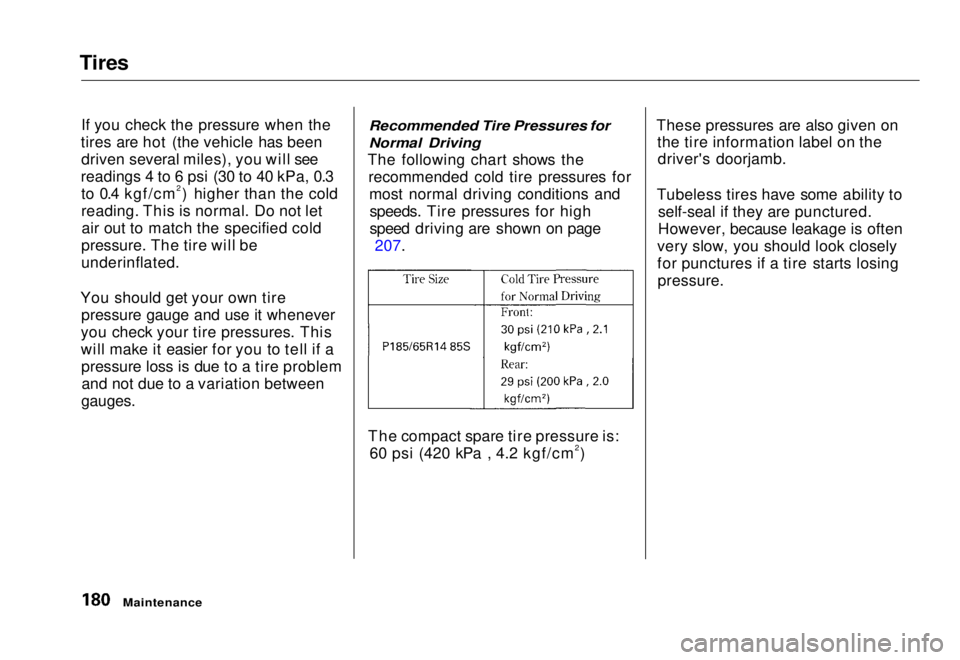
Tires
If you check the pressure when the
tires are hot (the vehicle has been driven several miles), you will see
readings 4 to 6 psi (30 to 40 kPa, 0.3 to 0.4 kgf/cm2) higher than the cold
reading. This is normal. Do not letair out to match the specified cold
pressure. The tire will be
underinflated.
You should get your own tire pressure gauge and use it whenever
you check your tire pressures. This
will make it easier for you to tell if a pressure loss is due to a tire problemand not due to a variation between
gauges.
Recommended Tire Pressures for
Normal Driving
The following chart shows the recommended cold tire pressures formost normal driving conditions andspeeds. Tire pressures for high
speed driving are shown on page 207.
The compact spare tire pressure is: 60 psi (420 kPa , 4.2 kgf/cm2) These pressures are also given on
the tire information label on thedriver's doorjamb.
Tubeless tires have some ability to self-seal if they are punctured.
However, because leakage is often
very slow, you should look closely
for punctures if a tire starts losing pressure.
MaintenanceMain Menu Table of Contents s t
Page 184 of 251

Tires
Replacing Tires and Wheels
The tires that came with your vehicle were selected to match the performance capabilities of the
vehicle while providing the best combination of handling, ride
comfort, and long life. You should
replace them with radial tires of thesame size, load range, speed rating,
and maximum cold tire pressure
rating (as shown on the tire's sidewall). Mixing radial and bias-ply
tires on your vehicle can reduce its
braking ability, traction, and steering
accuracy.
It is best to replace all four tires at
the same time. If that is not possible
or necessary, then replace the two
front tires or the two rear tires as a
pair. Replacing just one tire can seriously affect your vehicle's han-
dling.
The ABS works by comparing the
speed of the wheels. When replacing
tires, use the same size originally supplied with the vehicle. Tire size
and construction can affect wheel speed and may cause the system to
work inconsistently.
If you ever need to replace a wheel,
make sure the wheel's specifications
match those of the original wheel
that came on your vehicle. Re-
placement wheels are available at
your Honda dealer.
Maintenance
Installing improper tires on your
vehicle can affect handling and
stability. This can cause a crash in which you can be seriously
hurt or killed.
Always use the size and type of
tires recommended in this owner's manual.Main Menu Table of Contents s t
Page 205 of 251

Taking Care of the Unexpected
This section covers the more- common problems that motoristsexperience with their vehicles. It
gives you information about how to safely evaluate the problem and what
to do to correct it. If the problem has stranded you on the side of the road,
you may be able to get going again. If not, you will also find instructionson getting your vehicle towed. Compact Spare Tire....................... 206
Changing a Flat Tire..................... 207
If Your Engine Won't Start........... 212
Nothing Happens or theStarter Motor OperatesVery Slowly............................. 212
The Starter Operates
Normally.................................213
Jump Starting................................. 213
If Your Engine Overheats............. 215
Low Oil Pressure Indicator.......... 217
Charging System Indicator........... 218
Malfunction Indicator Lamp ........ 219
Brake System Indicator................ 220
Closing the Moonroof................... 221
Fuses............................................... 222
Checking and Replacing........... 223
Emergency Towing....................... 227
Taking Care of the UnexpectedMain Menu s t
Page 206 of 251
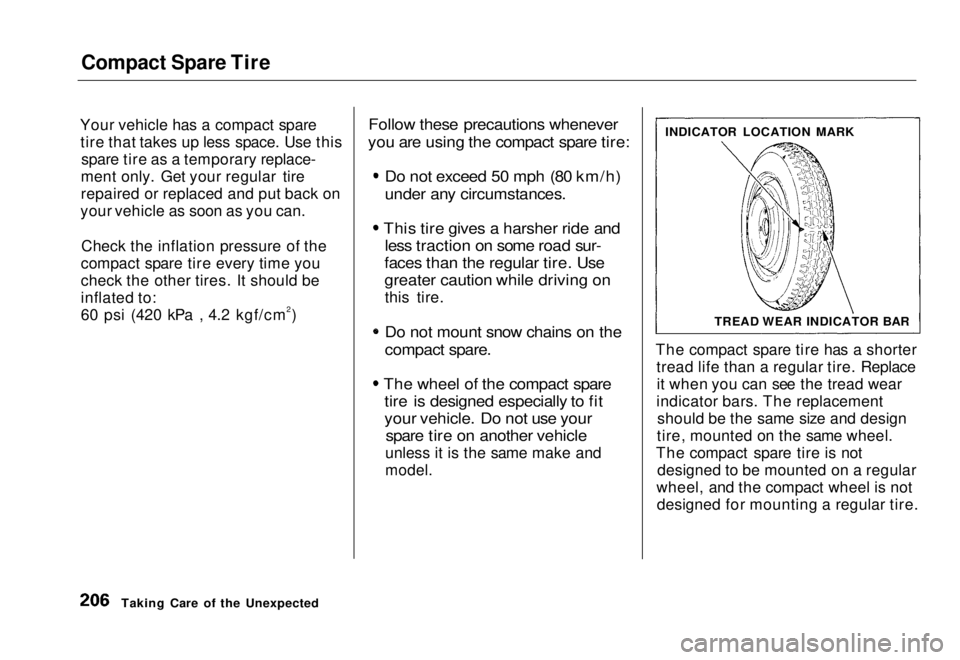
Compact Spare Tire
Your vehicle has a compact spare tire that takes up less space. Use this spare tire as a temporary replace-
ment only. Get your regular tire
repaired or replaced and put back on
your vehicle as soon as you can.
Check the inflation pressure of the
compact spare tire every time you
check the other tires. It should be
inflated to:
60 psi (420 kPa , 4.2 kgf/cm2)
Follow these precautions whenever
you are using the compact spare tire:
Do not exceed 50 mph (80 km/h)
under any circumstances.
This tire gives a harsher ride and less traction on some road sur-
faces than the regular tire. Use
greater caution while driving on
this tire.
Do not mount snow chains on the
compact spare.
The wheel of the compact spare tire is designed especially to fit
your vehicle. Do not use your spare tire on another vehicle
unless it is the same make and
model.
The compact spare tire has a shorter
tread life than a regular tire. Replaceit when you can see the tread wear
indicator bars. The replacement should be the same size and design
tire, mounted on the same wheel.
The compact spare tire is not designed to be mounted on a regular
wheel, and the compact wheel is not designed for mounting a regular tire.
Taking Care of the Unexpected INDICATOR LOCATION MARK
TREAD WEAR INDICATOR BARMain Menu Table of Contents s t
Page 229 of 251
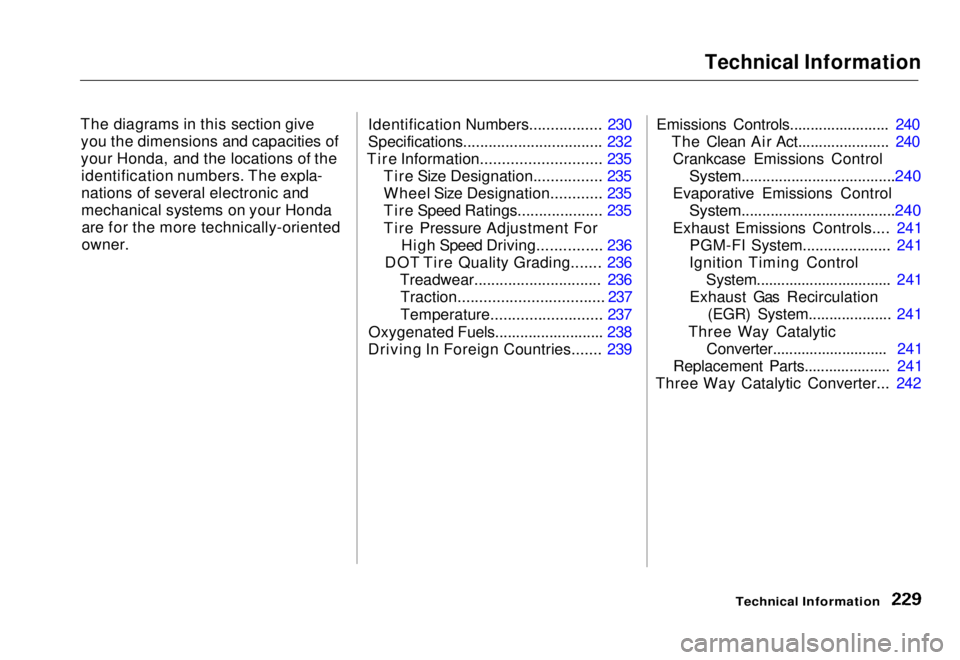
Technical Information
The diagrams in this section give you the dimensions and capacities of
your Honda, and the locations of theidentification numbers. The expla-
nations of several electronic and
mechanical systems on your Hondaare for the more technically-oriented
owner. Identification Numbers................. 230
Specifications................................. 232
Tire Information............................ 235 Tire Size Designation................ 235
Wheel Size Designation............ 235
Tire Speed Ratings.................... 235
Tire Pressure Adjustment For High Speed Driving............... 236
DOT Tire Quality Grading....... 236 Treadwear.............................. 236Traction.................................. 237
Temperature.......................... 237
Oxygenated Fuels.......................... 238
Driving In Foreign Countries....... 239 Emissions Controls........................ 240
The Clean Air Act...................... 240Crankcase Emissions Control
System.....................................240
Evaporative Emissions Control
System.....................................240
Exhaust Emissions Controls.... 241 PGM-FI System..................... 241
Ignition Timing Control System................................. 241
Exhaust Gas Recirculation (EGR) System.................... 241
Three Way Catalytic Converter............................ 241
Replacement Parts..................... 241
Three Way Catalytic Converter... 242
Technical InformationMain Menu s t
Page 236 of 251
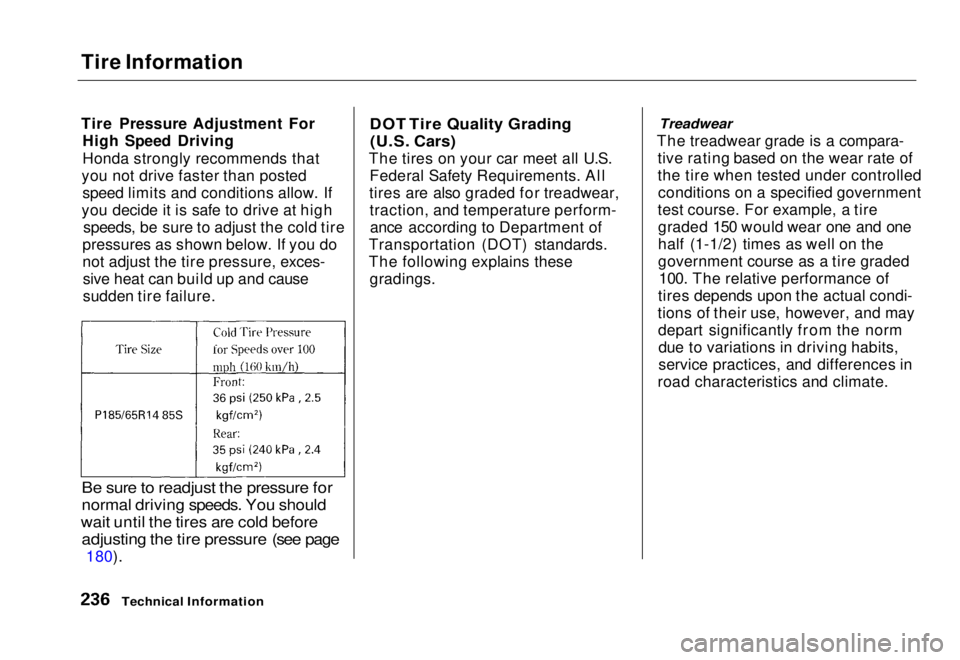
Tire Information
Tire Pressure Adjustment For
High Speed Driving
Honda strongly recommends that
you not drive faster than posted speed limits and conditions allow. If
you decide it is safe to drive at high speeds, be sure to adjust the cold tire
pressures as shown below. If you do
not adjust the tire pressure, exces- sive heat can build up and cause
sudden tire failure.
Be sure to readjust the pressure for
normal driving speeds. You should
wait until the tires are cold before
adjusting the tire pressure (see page
180).
DOT Tire Quality Grading
(U.S. Cars)
The tires on your car meet all U.S. Federal Safety Requirements. All
tires are also graded for treadwear, traction, and temperature perform-ance according to Department of
Transportation (DOT) standards.
The following explains these gradings.
Treadwear
The treadwear grade is a compara- tive rating based on the wear rate of
the tire when tested under controlledconditions on a specified government
test course. For example, a tire graded 150 would wear one and one
half (1-1/2) times as well on the
government course as a tire graded 100. The relative performance of
tires depends upon the actual condi-
tions of their use, however, and may depart significantly from the normdue to variations in driving habits,
service practices, and differences in
road characteristics and climate.
Technical InformationMain Menu Table of Contents s t
Page 246 of 251
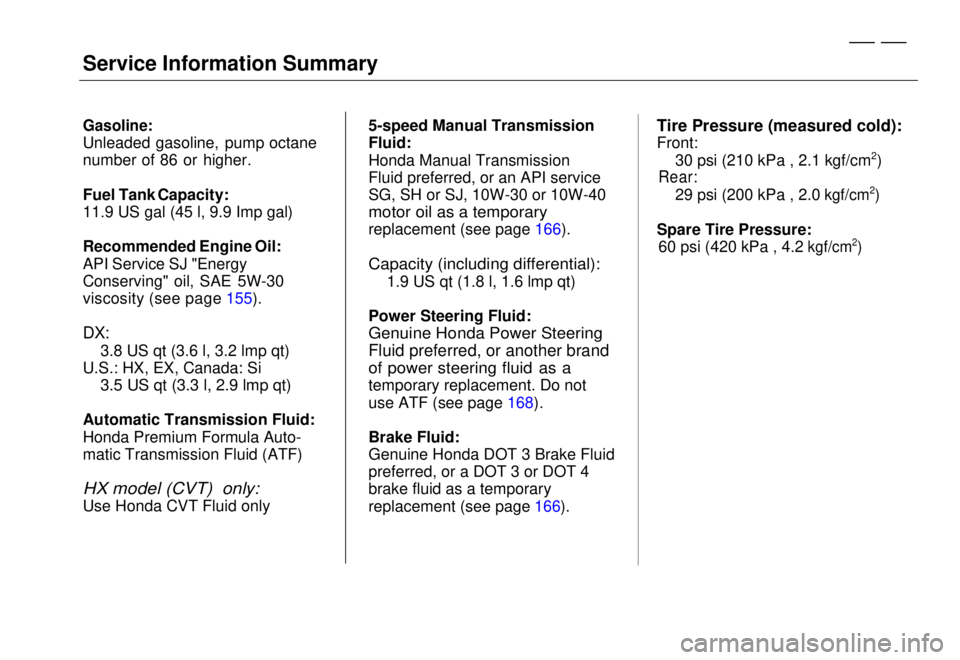
Gasoline:
Unleaded gasoline, pump octane
number of 86 or higher.
Fuel Tank Capacity:
11.9 US gal (45 l, 9.9 Imp gal)
Recommended Engine Oil:
API Service SJ "Energy
Conserving" oil, SAE 5W-30
viscosity (see page 155).
DX:
3.8 US qt (3.6 l, 3.2 lmp qt)
U.S.: HX, EX, Canada: Si
3.5 US qt (3.3 l, 2.9 lmp qt)
Automatic Transmission Fluid:
Honda Premium
Formula Auto-
matic Transmission Fluid (ATF)
HX model (CVT)
only:
Use Honda CVT Fluid only 5-speed Manual Transmission
Fluid:
Honda Manual Transmission
Fluid preferred, or an API service
SG, SH or SJ,
10W-30 or 10W-40
motor oil as a temporary
replacement (see page 166).
Capacity (including differential):
1.9 US qt (1.8 l, 1.6 lmp qt)
Power Steering Fluid:
Genuine Honda Power Steering
Fluid preferred, or another brand
of power steering fluid as a
temporary replacement. Do not
use ATF (see page 168).
Brake
Fluid:
Genuine Honda DOT 3 Brake Fluid
preferred, or a DOT 3 or DOT 4
brake fluid as a temporary
replacement (see page
166).
Tire Pressure (measured cold):
Front:
30 psi (210 kPa , 2.1 kgf/cm2)
Rear:
29 psi (200 kPa , 2.0
kgf/cm2
)
Spare Tire Pressure:
60 psi (420 kPa , 4.2
kgf/cm 2
)
Service
Information SummaryMain Menu s t